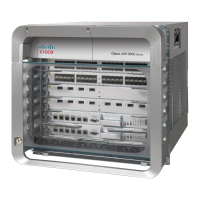64
Cisco ASR 9000 Series Aggregation Services Router Getting Started Guide
OL-28417-02
Chapter Configuring General Router Features
Configuring the Hostname
RP/0//CPU0:router(config-if)# description this is my interface
RP/0//CPU0:router(config-if)# ipv4 address 10.1.1.1 255.0.0.0
RP/0//CPU0:router(config-if)# shutdown
RP/0//CPU0:router(config-if)# abort
RP/0//CPU0:router#
Configuring the Hostname
The hostname identifies an on the network. Although devices can be uniquely identified by their Layer
2 and Layer 3 addresses (such as an IP address), it is often simpler to remember network devices by an
alphanumeric “hostname.” This name is used in the CLI prompt and default configuration filenames and
to identify the on the network.
To configure the hostname, enter the hostname command with the name as shown in the following
example:
RP/0//CPU0:router# configure
RP/0//CPU0:router(config)# hostname SDR_SJ
RP/0//CPU0:router(config)# commit
RP/0//CPU0:Apr 7 00:07:33.246 : config[65669]: %LIBTARCFG-6-COMMIT : Configuration
committed by user 'user_a'. Use 'show configuration commit changes 1000000067' to view
the changes.
RP/0//CPU0:SDR_SJ(config)#
The preceding example sets the name to SDR_SJ.
Note No blanks or spaces are permitted as part of a name. Do not expect case to be preserved. Uppercase and
lowercase characters look the same to many Internet software applications. It may seem appropriate to
capitalize a name the same way you might if you were writing, but conventions dictate that computer
names appear all lowercase. For more information, see RFC 1178, Choosing a Name for Your Computer.
Configuring the Management Ethernet Interface
The Management Ethernet interface on the is used to connect the router to a network for remote
management using a Telnet client, the Simple Network Management Protocol (SNMP), or other
management agents. The following sections provide information on the Management Ethernet interface:
• Specifying the Management Ethernet Interface Name in CLI Commands, page 86
• Displaying the Available Management Ethernet Interfaces, page 87
• Configuring the Management Ethernet Interface, page 89

